SteamWorld Quest: Hand of Gilgamech is part of the genre-spanning SteamWorld franchise. This outing takes the form of a turn-based RPG. I follow the story of Armilly and Copernica, two friends who return from an errand in the forest to find their hometown under attack by robots from the evil Void Army. I guide the pair as they assemble a party of heroes and battle across a fantasy twist on SteamWorld’s usual steampunk setting to reclaim a cursed artifact from legend and stop the Void Army’s march of destruction.
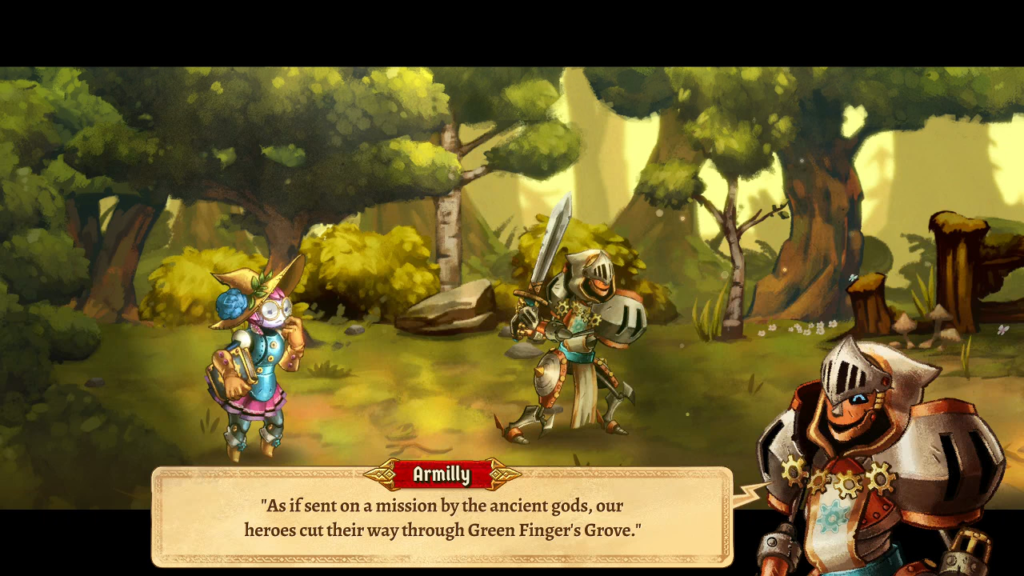
I begin the first chapter following a pair of unexpected heroes. Armilly is a wannabe knight who wears armor several sizes too big for her, is prone to narrating the party’s most mundane accomplishments in lurid and fantastical prose, and idolizes members of the local hero’s guild; if it weren’t for her young age, she could be a youthful alternative to Don Quixote. Copernica, by contrast, is no Sancho Panza. A former student of the local magic academy, she wears a pointed hat and heavy gloves that evoke both a witch’s and a gardener’s garb, leaning into how Quest’s form of magic uses alchemy to create its elemental effects. Copernica is the group’s clear intellectual leader and there is no resentment felt from her friend, even though Armilly is nominally the story’s central character.
Armilly and Copernica are soon joined by their friend Galleo, a huge robot with the characteristics of a frog. Timid and cowardly, he would rather remain in his mother’s basement than go on a world-saving adventure. He gets roped into events anyway. The trio becomes a quartet when they encounter Orik, a former traveling companion of the legendary hero Gilgamech whose design is reminiscent of a samurai rōnin. All the prerequisite tropes for this archetype are present, including my discomfort with its inclusion by non-Japanese artists (Quest’s developers are Swedish). The group is rounded out by Tarah and Thayne, devious and bloodthirsty child thieves who team up during battles as a tandem player character.
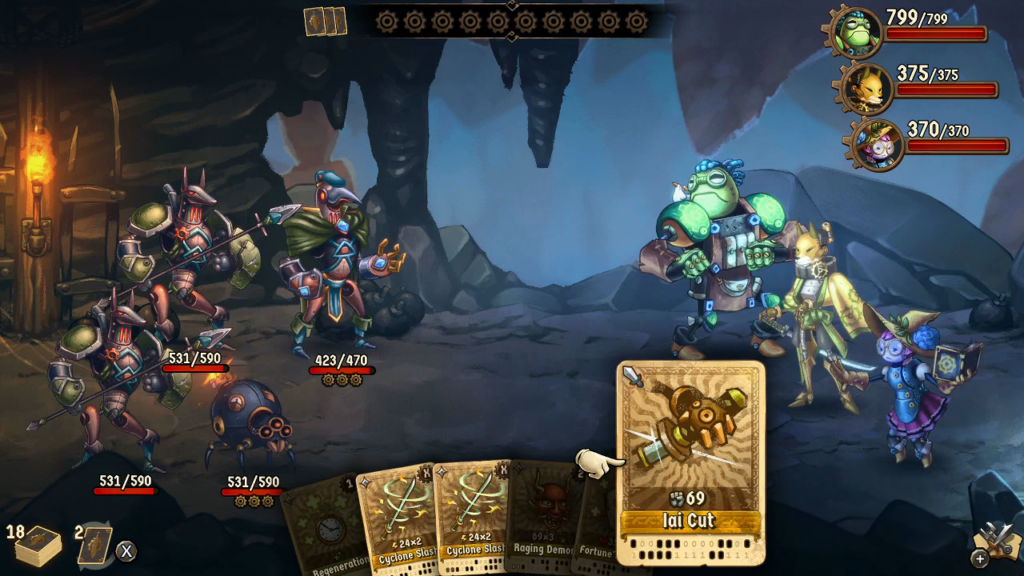
Whichever three of these five player characters I deploy, the subsequent RPG battle is not a traditional one. Both my party and the enemy’s take turns attacking, with the first to drain the other party’s hit points being the victor. The twist is the attacks and abilities they use are determined by cards drawn from a deck—and in a cute SteamWorld twist, these “cards” are computer programming punch cards rather than playing cards. Each character in my three-person team must have eight cards assigned to their deck, no more or less, which are drawn in hands of six at the beginning of each turn. Cards are drawn at random; if I have Armilly in the battle but don’t draw any of her cards, she doesn’t get to act that turn.
Cards come in three varieties: Strikes, Upgrades, and Skills. Strikes deal basic damage to a single enemy and Upgrades buff a player character’s stats in some way. They may be used for free, each generating one point of Steam Power which is tracked on a meter at the top of the screen. Steam Power is used to activate Skills, cards with more potent damage and status affecting potential than Strikes and Upgrades. Each turn consists of playing three of these cards in any combination.
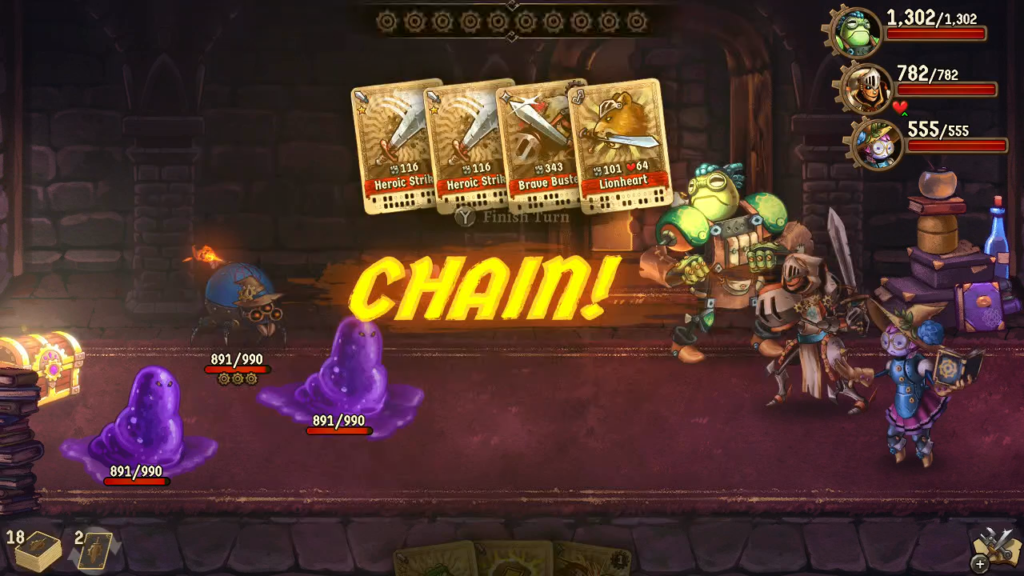
This system is embellished by Heroic Chains and Combos. If I can play three cards in a turn from one character, then they will add a Heroic Chain to the end of their action string. These extra-powerful abilities complement their core abilities, often adding the finishing touch to an enemy’s hit points or the final restorative flourish to the party’s.
When a Heroic Chain isn’t possible, then Combo cards step in. These add extra effects to a single attack when its card is paired with another party member’s card. It’s a consolation prize of failed strategy; my goal in almost every turn is to execute a Heroic Chain, but a Combo is a good compromise when the cards aren’t in my favor.
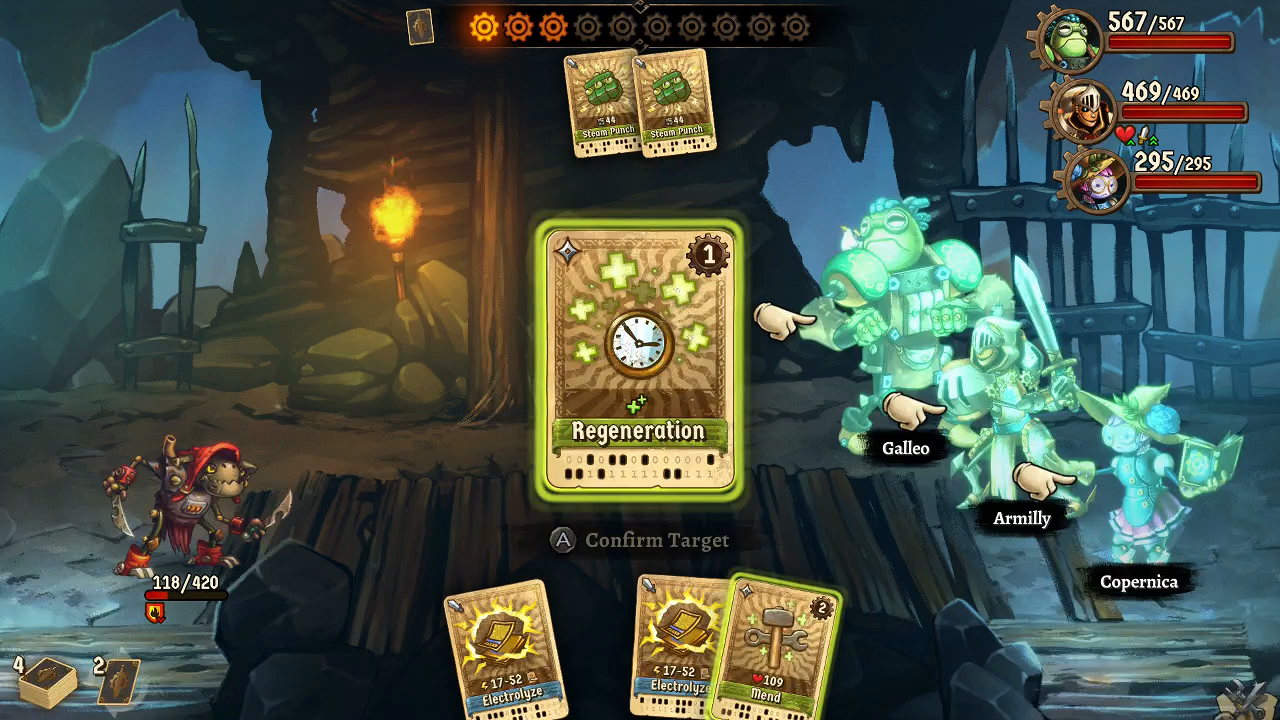
As I begin building the decks each character deploys in battle, I notice how different cards can synergize with each other to push a character towards one of two class roles.
Armilly can specialize in abilities that deal good damage and also restore her health, or take a riskier approach towards abilities that grow stronger the less health she has. Galleo can focus on either healing the party’s damage, or drawing damage to himself to protect his party members. Reflecting his age and experience, Orik is the most diverse party member, able to act as a damage dealer focused on critical hits, a healer who restores his allies with every swing of his weapon, or a tank who intercepts then dodges all incoming damage. The flexibility in party composition is admirable, though the eight-card limit per character ensures I have to make decisive choices. One or two cards that don’t contribute to the character’s strategy leads to a quickly lost battle.
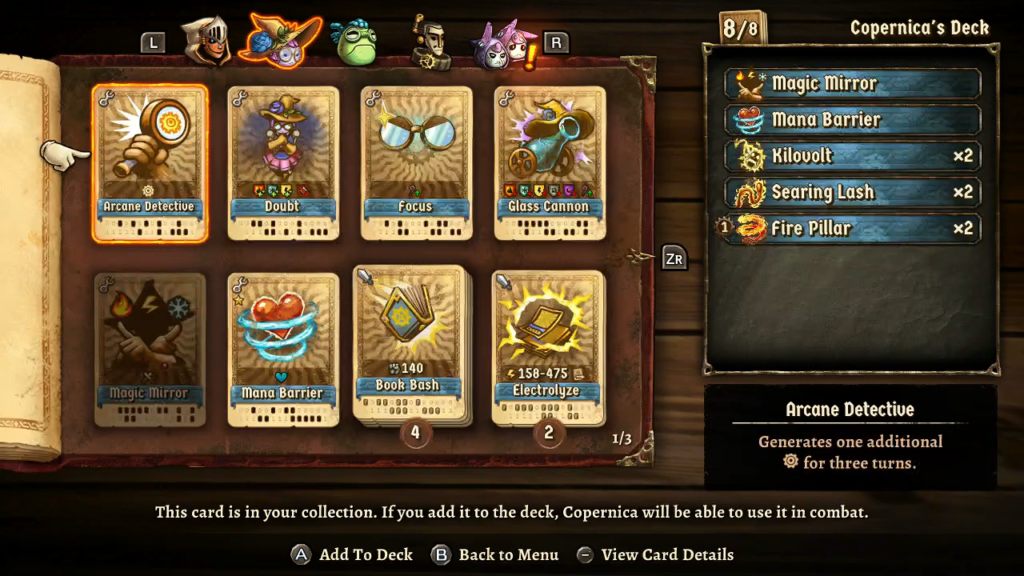
The trouble with these flexible systems is Quest later burdens me with too many cards. Each character’s initial clear vision of diverging and complementary party roles is burdened by another new potential role, then another, and then another, created by a constant stream of new cards introduced in every level. Keeping track of all these new cards, let alone crafting or upgrading them at each level’s traveling merchant, becomes overwhelming. I confess that once I find a strategy that works, I stick with it and ignore the dozens of new cards dropped in my lap. Through the ever-expanding card collection, Quest seems to mistake complexity for depth.
I only wish Quest had made the same mistake for its level design. “Plain” would be overstating the situation. Every single environment consists of rectangular rooms arrayed on a map and connected by straight paths. All that differentiates them between four distinct settings is set dressing. In form and function, every single level in Quest is exactly the same.
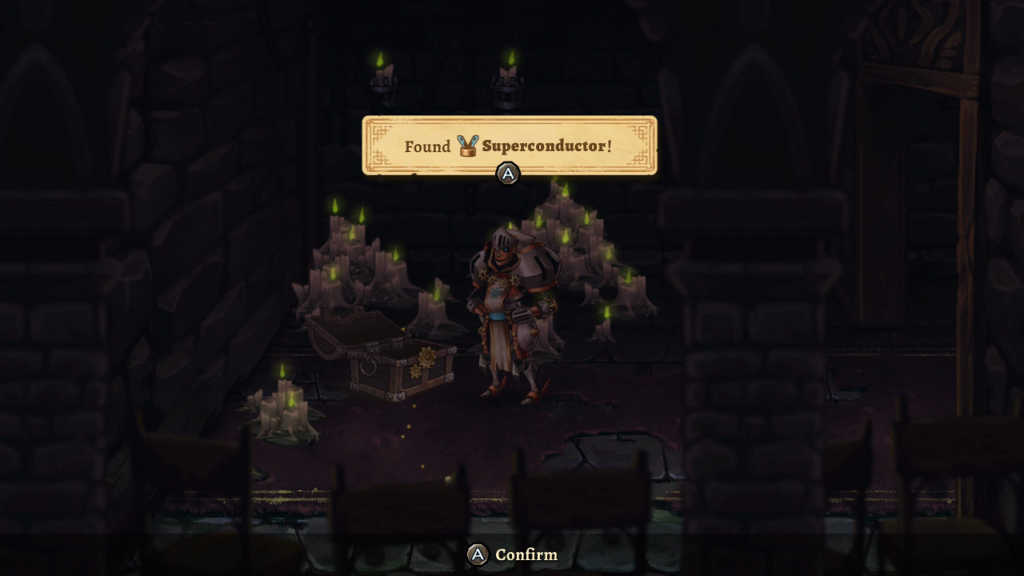
Ensuring I don’t miss any of the treasures sequestered in Quest’s hidden corners takes the bland and repetitive level design and exacerbates it into aggravation. Chests containing powerful new cards and items are hidden in every level, stashed behind foreground scenery and down hidden paths that can only be found by squeezing the player character into invisible gaps between level decoration. Finding every chest demands walking into every wall and object across thirteen explorable chapters. I’m sick of doing it before I’m done with the third.
The combat system is Quest’s strong suit, and it wisely chooses to expand on these systems to keep me occupied after I’ve finished the main story. There are multiple difficulty levels by default—the focus-on-the-story Squire, the challenging-but-fair Knight, and the test-your-skill Legend—which are joined by a New Game Plus-style Legend Remix that ramps the difficulty to grueling levels after I beat the final boss for the first time. There is also an arena which offers progressively more challenging battle marathons, including a boss rush that is Quest’s most intimidating challenge.

The best thing about the SteamWorld series as a whole is their unpredictability. Entries shift from tower defense to non-linear platformer to tactical shooter to management simulation. Years often go by between new releases, giving the current installments time to become a part of the series texture. Whatever the individual design of each installment, they track the radical transformations of SteamWorld and the robots who inhabit it while maintaining a self-deprecating sense of humor and basic set of thematic rules its characters must follow.
Quest is the least impactful addition to the SteamWorld setting. It is a bedtime story, told by Heist party member Gabriel “Seabrass” Stubb to his son, though this framing device is immediately forgotten once the adventure begins. SteamWorld’s recurring nemesis, the Vectron Voltbots, are not mentioned at all, replaced by various fantasy creatures with a roboticized twist. It’s not clear to me the story is even meant to take place on the same planet as previous SteamWorld adventures. Quest is merely a piece of SteamBot mythology, and not a particularly informative one at that.
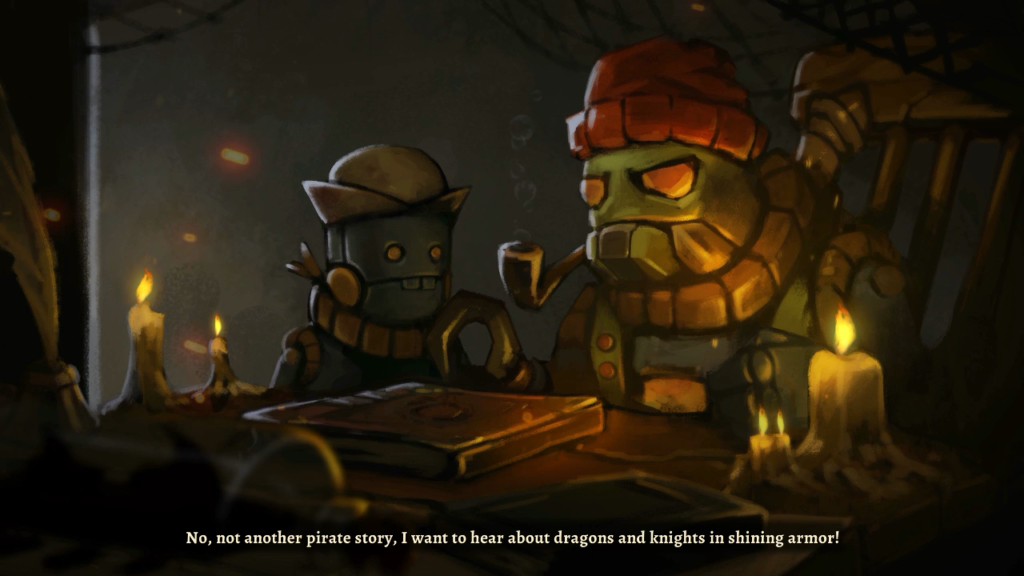
Quest isn’t a wasted entry, though. The giant character models are beautifully colorful and highly-detailed, as though plucked straight out of Seabrass’ illustrated storybook. They give the best look at how SteamBots are built and move, details which were often obscured by previous entries’ smaller models in large, detailed environments.
Quest may also have SteamWorld’s best-realized characters. Armilly, Copernica, and Orik in particular undergo interesting character arcs. Armilly is confronted with the true personalities of those she idolizes and reaches a more nuanced and proactive understanding of heroism. Copernica learns not to run away from her mistakes and step up when she believes something. Orik is once again the most dynamic character, slowly revealing an idealism that he hides beneath a detached mysticism that proves to be Quest’s central theme.
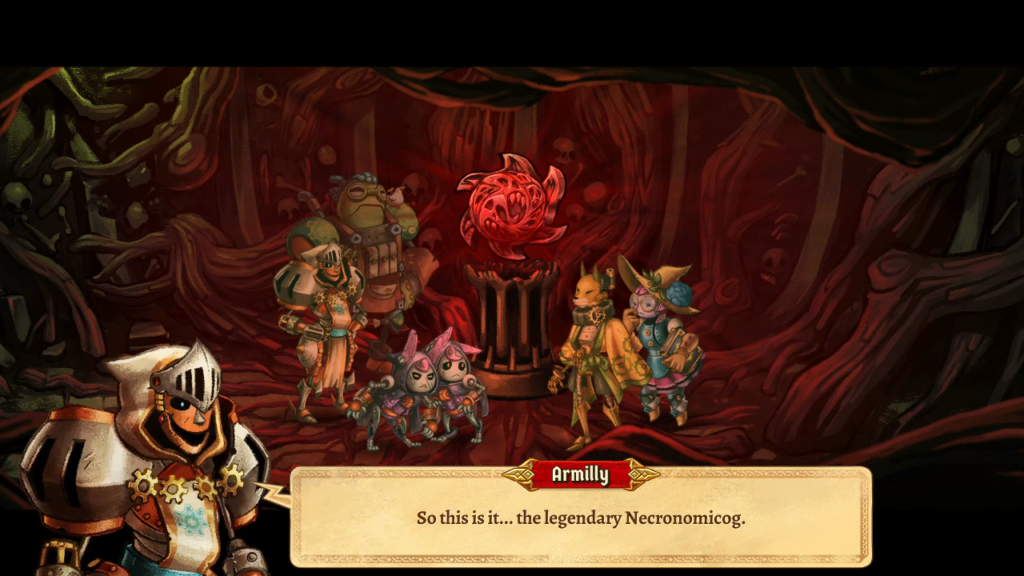
As I have played each SteamWorld videogame, I have felt their ambition and potential, but also felt most fall short. The clear best of the lot, Dig 2, benefits greatly from building on the bones left by its predecessor; it remains the only direct sequel and the only entry to benefit from those bones. What I see in SteamWorld Quest: Hand of Gilgamech is a good videogame that has the potential through refinement to be a much better one. The RPG battles begin interesting, but become mired by too many ability cards and too many class roles to choose between. The levels are uninspired and interchangeable. The story and characters, while good on their own terms, don’t feel as indelible to the setting’s fabric as other entries. I’m not disappointed by Quest, but I am more intrigued by what could be than by what is here.